Comprehensive Analysis of Job Design: Employees and Employers
VerifiedAdded on 2021/06/14
|9
|2400
|59
Report
AI Summary
This report delves into the multifaceted concept of job design, exploring its significance in shaping the roles and responsibilities of employees within organizations. The analysis focuses on the perspectives of both employees and employers, highlighting how job design, as a framework developed by human resources departments, influences employee behavior, attitudes, and overall performance. The report examines the advantages, such as improved employee engagement, streamlined task allocation, and enhanced organizational goal alignment, as well as the disadvantages, like potential limitations on employee autonomy and the risk of favoring employer interests. It further discusses how job design impacts various aspects of work, including skill development, motivation, and the ability of employees to adapt to new challenges. The report also touches upon the use of job design in fostering a competitive work environment, particularly through performance monitoring and feedback mechanisms, as seen in companies like Deloitte. Overall, the report provides a comprehensive overview of job design, its implications for both employees and employers, and its role in modern organizational management.
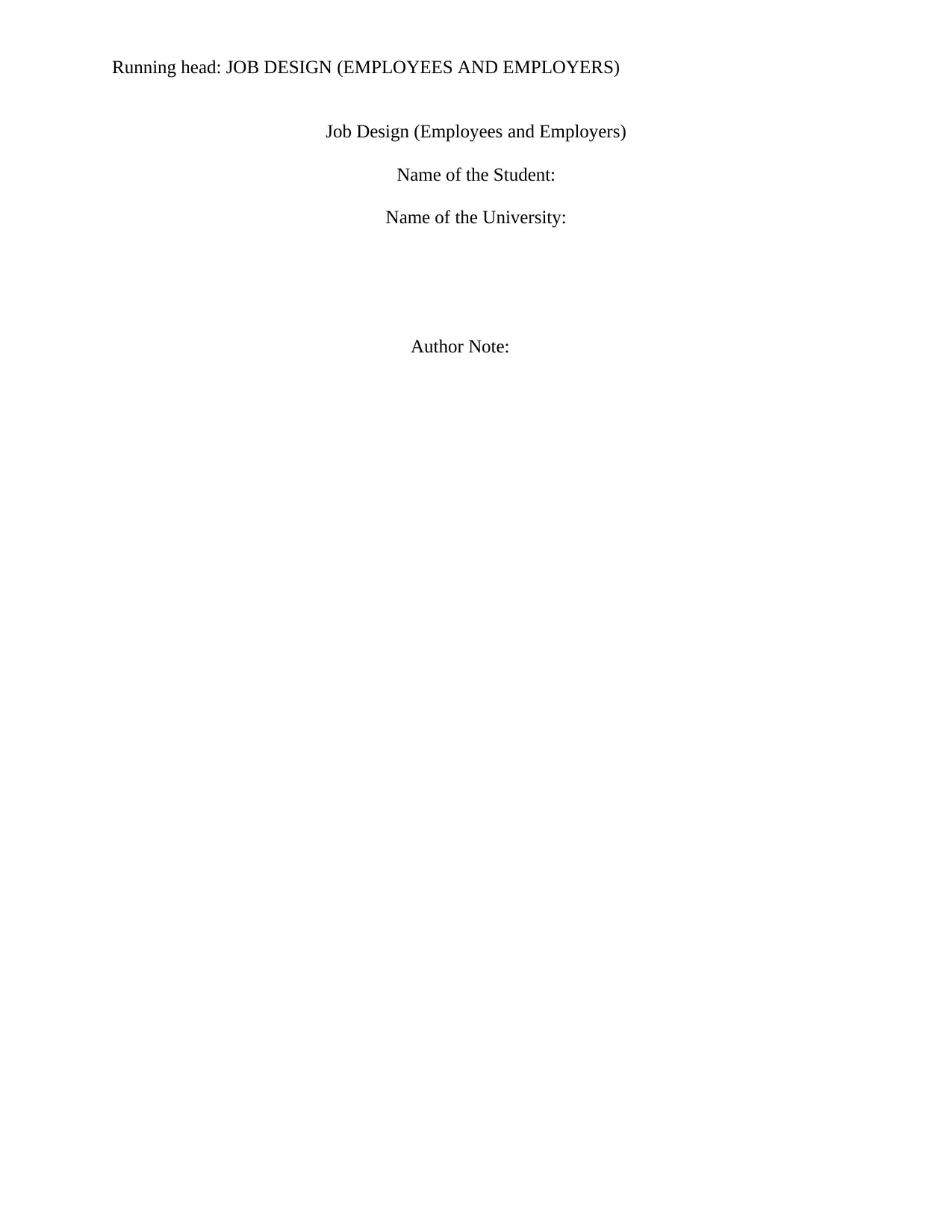
Running head: JOB DESIGN (EMPLOYEES AND EMPLOYERS)
Job Design (Employees and Employers)
Name of the Student:
Name of the University:
Author Note:
Job Design (Employees and Employers)
Name of the Student:
Name of the University:
Author Note:
Paraphrase This Document
Need a fresh take? Get an instant paraphrase of this document with our AI Paraphraser
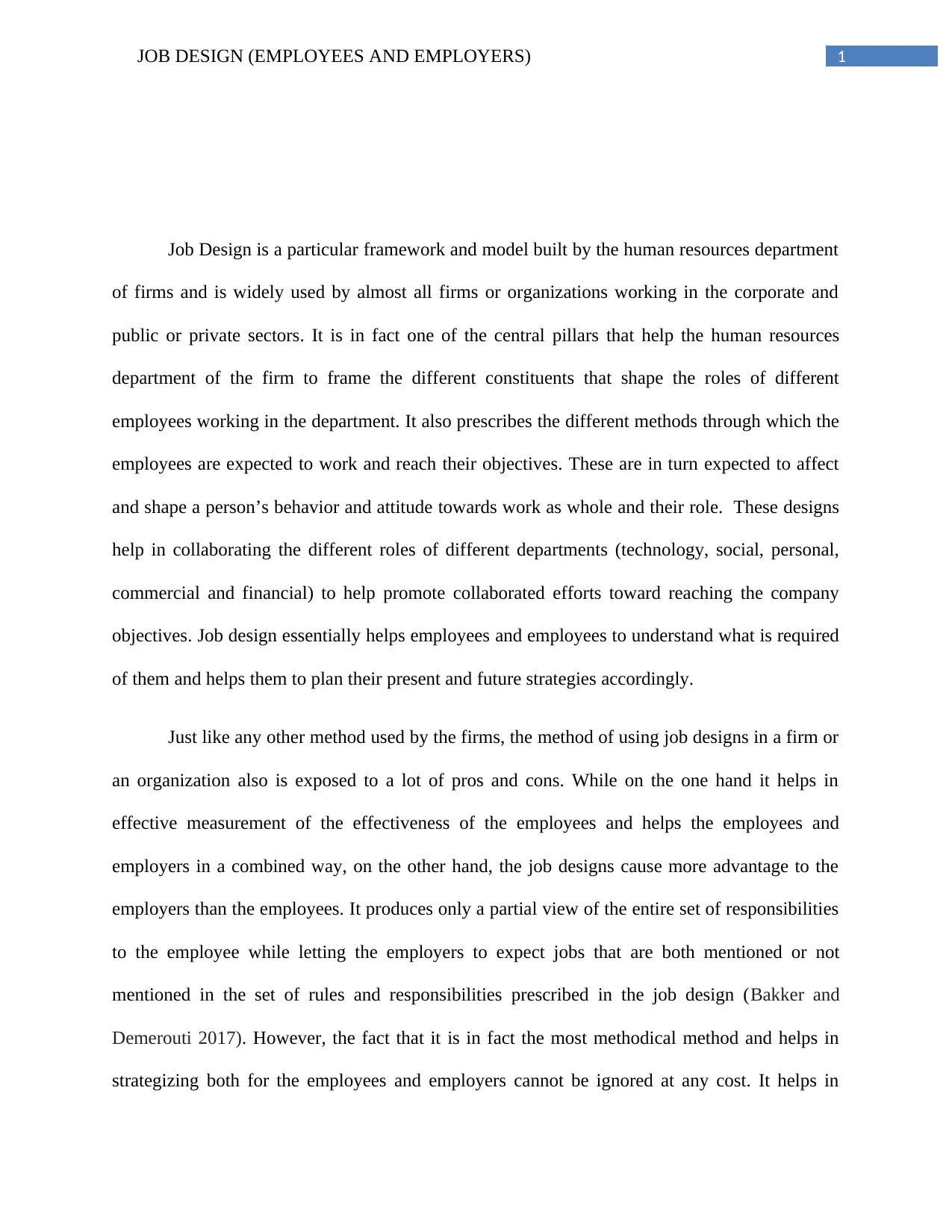
1JOB DESIGN (EMPLOYEES AND EMPLOYERS)
Job Design is a particular framework and model built by the human resources department
of firms and is widely used by almost all firms or organizations working in the corporate and
public or private sectors. It is in fact one of the central pillars that help the human resources
department of the firm to frame the different constituents that shape the roles of different
employees working in the department. It also prescribes the different methods through which the
employees are expected to work and reach their objectives. These are in turn expected to affect
and shape a person’s behavior and attitude towards work as whole and their role. These designs
help in collaborating the different roles of different departments (technology, social, personal,
commercial and financial) to help promote collaborated efforts toward reaching the company
objectives. Job design essentially helps employees and employees to understand what is required
of them and helps them to plan their present and future strategies accordingly.
Just like any other method used by the firms, the method of using job designs in a firm or
an organization also is exposed to a lot of pros and cons. While on the one hand it helps in
effective measurement of the effectiveness of the employees and helps the employees and
employers in a combined way, on the other hand, the job designs cause more advantage to the
employers than the employees. It produces only a partial view of the entire set of responsibilities
to the employee while letting the employers to expect jobs that are both mentioned or not
mentioned in the set of rules and responsibilities prescribed in the job design (Bakker and
Demerouti 2017). However, the fact that it is in fact the most methodical method and helps in
strategizing both for the employees and employers cannot be ignored at any cost. It helps in
Job Design is a particular framework and model built by the human resources department
of firms and is widely used by almost all firms or organizations working in the corporate and
public or private sectors. It is in fact one of the central pillars that help the human resources
department of the firm to frame the different constituents that shape the roles of different
employees working in the department. It also prescribes the different methods through which the
employees are expected to work and reach their objectives. These are in turn expected to affect
and shape a person’s behavior and attitude towards work as whole and their role. These designs
help in collaborating the different roles of different departments (technology, social, personal,
commercial and financial) to help promote collaborated efforts toward reaching the company
objectives. Job design essentially helps employees and employees to understand what is required
of them and helps them to plan their present and future strategies accordingly.
Just like any other method used by the firms, the method of using job designs in a firm or
an organization also is exposed to a lot of pros and cons. While on the one hand it helps in
effective measurement of the effectiveness of the employees and helps the employees and
employers in a combined way, on the other hand, the job designs cause more advantage to the
employers than the employees. It produces only a partial view of the entire set of responsibilities
to the employee while letting the employers to expect jobs that are both mentioned or not
mentioned in the set of rules and responsibilities prescribed in the job design (Bakker and
Demerouti 2017). However, the fact that it is in fact the most methodical method and helps in
strategizing both for the employees and employers cannot be ignored at any cost. It helps in
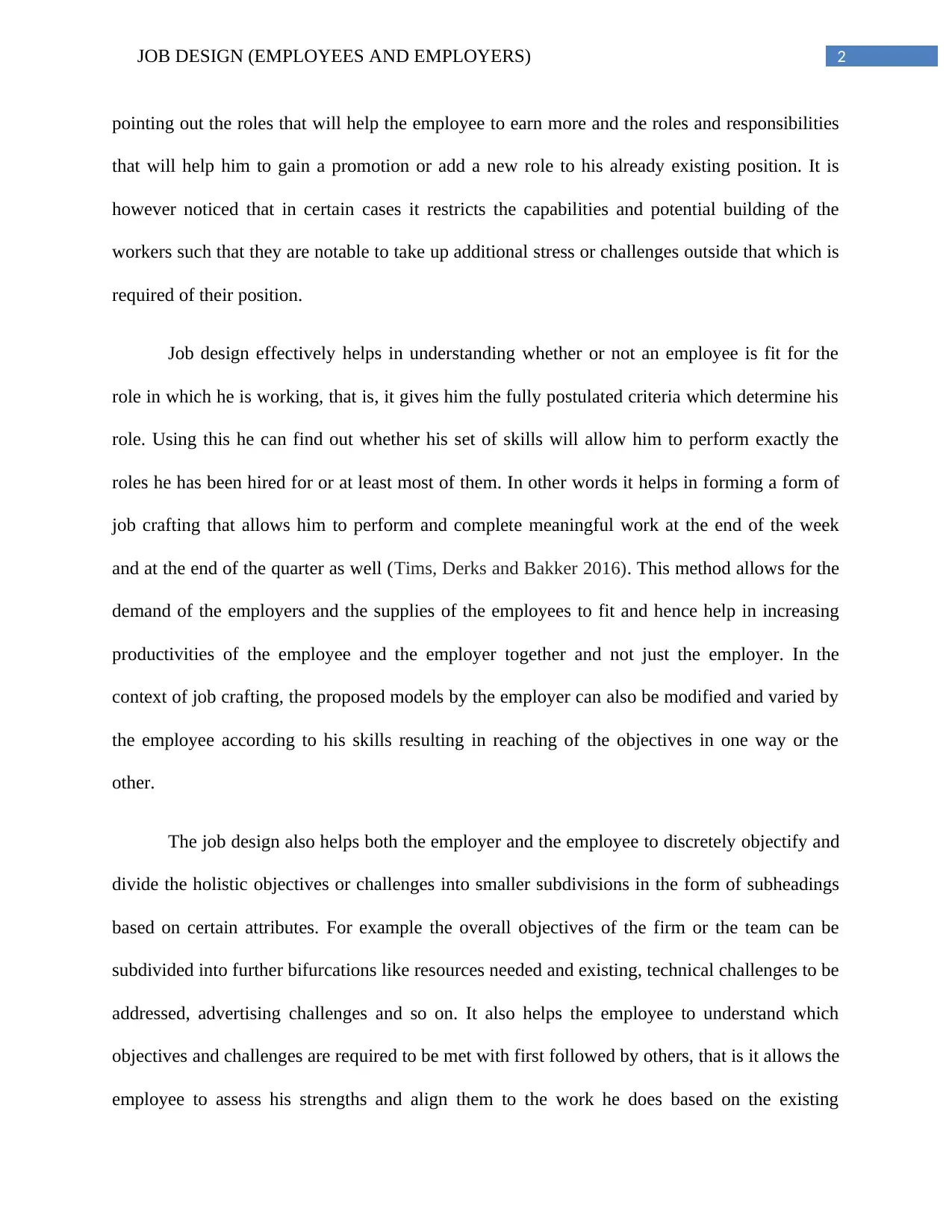
2JOB DESIGN (EMPLOYEES AND EMPLOYERS)
pointing out the roles that will help the employee to earn more and the roles and responsibilities
that will help him to gain a promotion or add a new role to his already existing position. It is
however noticed that in certain cases it restricts the capabilities and potential building of the
workers such that they are notable to take up additional stress or challenges outside that which is
required of their position.
Job design effectively helps in understanding whether or not an employee is fit for the
role in which he is working, that is, it gives him the fully postulated criteria which determine his
role. Using this he can find out whether his set of skills will allow him to perform exactly the
roles he has been hired for or at least most of them. In other words it helps in forming a form of
job crafting that allows him to perform and complete meaningful work at the end of the week
and at the end of the quarter as well (Tims, Derks and Bakker 2016). This method allows for the
demand of the employers and the supplies of the employees to fit and hence help in increasing
productivities of the employee and the employer together and not just the employer. In the
context of job crafting, the proposed models by the employer can also be modified and varied by
the employee according to his skills resulting in reaching of the objectives in one way or the
other.
The job design also helps both the employer and the employee to discretely objectify and
divide the holistic objectives or challenges into smaller subdivisions in the form of subheadings
based on certain attributes. For example the overall objectives of the firm or the team can be
subdivided into further bifurcations like resources needed and existing, technical challenges to be
addressed, advertising challenges and so on. It also helps the employee to understand which
objectives and challenges are required to be met with first followed by others, that is it allows the
employee to assess his strengths and align them to the work he does based on the existing
pointing out the roles that will help the employee to earn more and the roles and responsibilities
that will help him to gain a promotion or add a new role to his already existing position. It is
however noticed that in certain cases it restricts the capabilities and potential building of the
workers such that they are notable to take up additional stress or challenges outside that which is
required of their position.
Job design effectively helps in understanding whether or not an employee is fit for the
role in which he is working, that is, it gives him the fully postulated criteria which determine his
role. Using this he can find out whether his set of skills will allow him to perform exactly the
roles he has been hired for or at least most of them. In other words it helps in forming a form of
job crafting that allows him to perform and complete meaningful work at the end of the week
and at the end of the quarter as well (Tims, Derks and Bakker 2016). This method allows for the
demand of the employers and the supplies of the employees to fit and hence help in increasing
productivities of the employee and the employer together and not just the employer. In the
context of job crafting, the proposed models by the employer can also be modified and varied by
the employee according to his skills resulting in reaching of the objectives in one way or the
other.
The job design also helps both the employer and the employee to discretely objectify and
divide the holistic objectives or challenges into smaller subdivisions in the form of subheadings
based on certain attributes. For example the overall objectives of the firm or the team can be
subdivided into further bifurcations like resources needed and existing, technical challenges to be
addressed, advertising challenges and so on. It also helps the employee to understand which
objectives and challenges are required to be met with first followed by others, that is it allows the
employee to assess his strengths and align them to the work he does based on the existing
⊘ This is a preview!⊘
Do you want full access?
Subscribe today to unlock all pages.

Trusted by 1+ million students worldwide
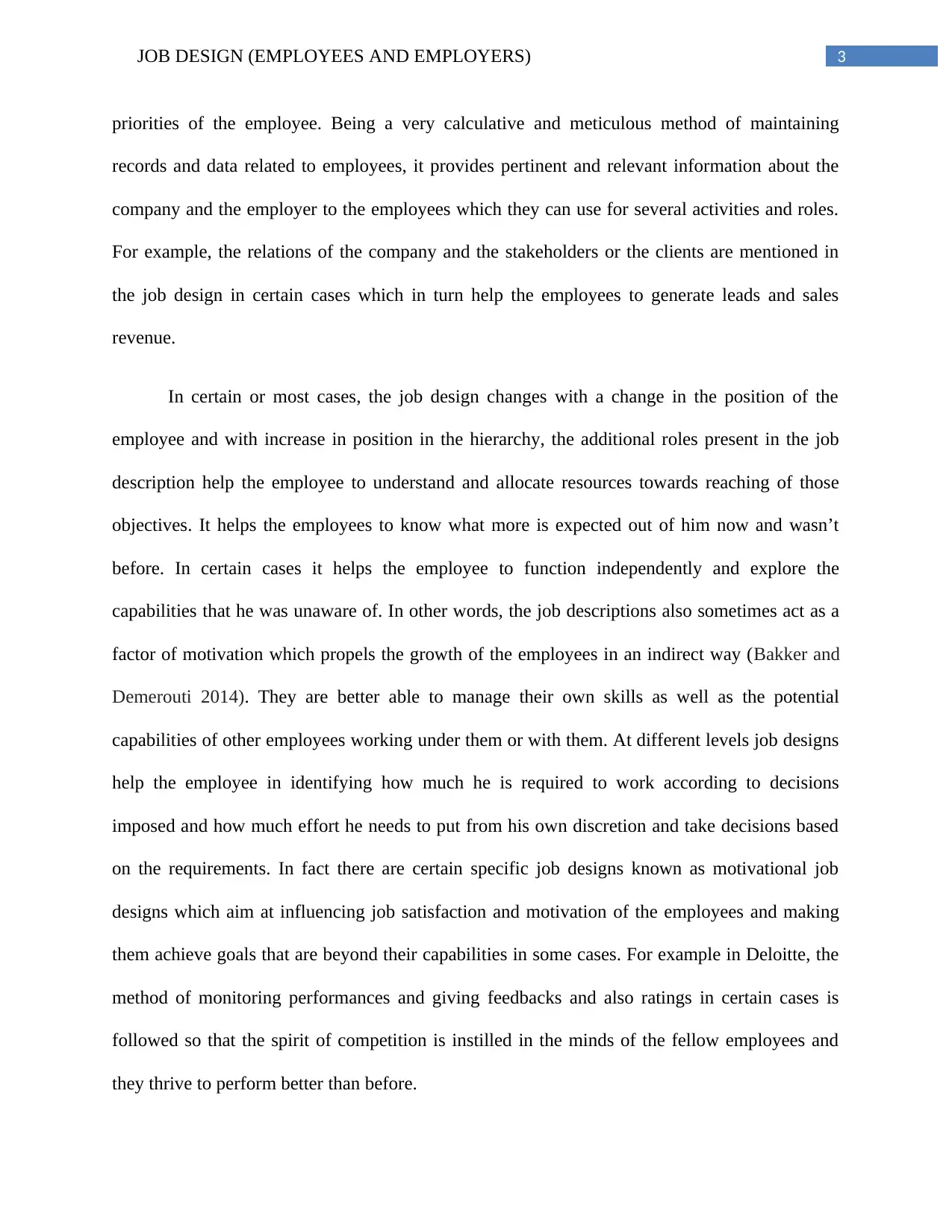
3JOB DESIGN (EMPLOYEES AND EMPLOYERS)
priorities of the employee. Being a very calculative and meticulous method of maintaining
records and data related to employees, it provides pertinent and relevant information about the
company and the employer to the employees which they can use for several activities and roles.
For example, the relations of the company and the stakeholders or the clients are mentioned in
the job design in certain cases which in turn help the employees to generate leads and sales
revenue.
In certain or most cases, the job design changes with a change in the position of the
employee and with increase in position in the hierarchy, the additional roles present in the job
description help the employee to understand and allocate resources towards reaching of those
objectives. It helps the employees to know what more is expected out of him now and wasn’t
before. In certain cases it helps the employee to function independently and explore the
capabilities that he was unaware of. In other words, the job descriptions also sometimes act as a
factor of motivation which propels the growth of the employees in an indirect way (Bakker and
Demerouti 2014). They are better able to manage their own skills as well as the potential
capabilities of other employees working under them or with them. At different levels job designs
help the employee in identifying how much he is required to work according to decisions
imposed and how much effort he needs to put from his own discretion and take decisions based
on the requirements. In fact there are certain specific job designs known as motivational job
designs which aim at influencing job satisfaction and motivation of the employees and making
them achieve goals that are beyond their capabilities in some cases. For example in Deloitte, the
method of monitoring performances and giving feedbacks and also ratings in certain cases is
followed so that the spirit of competition is instilled in the minds of the fellow employees and
they thrive to perform better than before.
priorities of the employee. Being a very calculative and meticulous method of maintaining
records and data related to employees, it provides pertinent and relevant information about the
company and the employer to the employees which they can use for several activities and roles.
For example, the relations of the company and the stakeholders or the clients are mentioned in
the job design in certain cases which in turn help the employees to generate leads and sales
revenue.
In certain or most cases, the job design changes with a change in the position of the
employee and with increase in position in the hierarchy, the additional roles present in the job
description help the employee to understand and allocate resources towards reaching of those
objectives. It helps the employees to know what more is expected out of him now and wasn’t
before. In certain cases it helps the employee to function independently and explore the
capabilities that he was unaware of. In other words, the job descriptions also sometimes act as a
factor of motivation which propels the growth of the employees in an indirect way (Bakker and
Demerouti 2014). They are better able to manage their own skills as well as the potential
capabilities of other employees working under them or with them. At different levels job designs
help the employee in identifying how much he is required to work according to decisions
imposed and how much effort he needs to put from his own discretion and take decisions based
on the requirements. In fact there are certain specific job designs known as motivational job
designs which aim at influencing job satisfaction and motivation of the employees and making
them achieve goals that are beyond their capabilities in some cases. For example in Deloitte, the
method of monitoring performances and giving feedbacks and also ratings in certain cases is
followed so that the spirit of competition is instilled in the minds of the fellow employees and
they thrive to perform better than before.
Paraphrase This Document
Need a fresh take? Get an instant paraphrase of this document with our AI Paraphraser
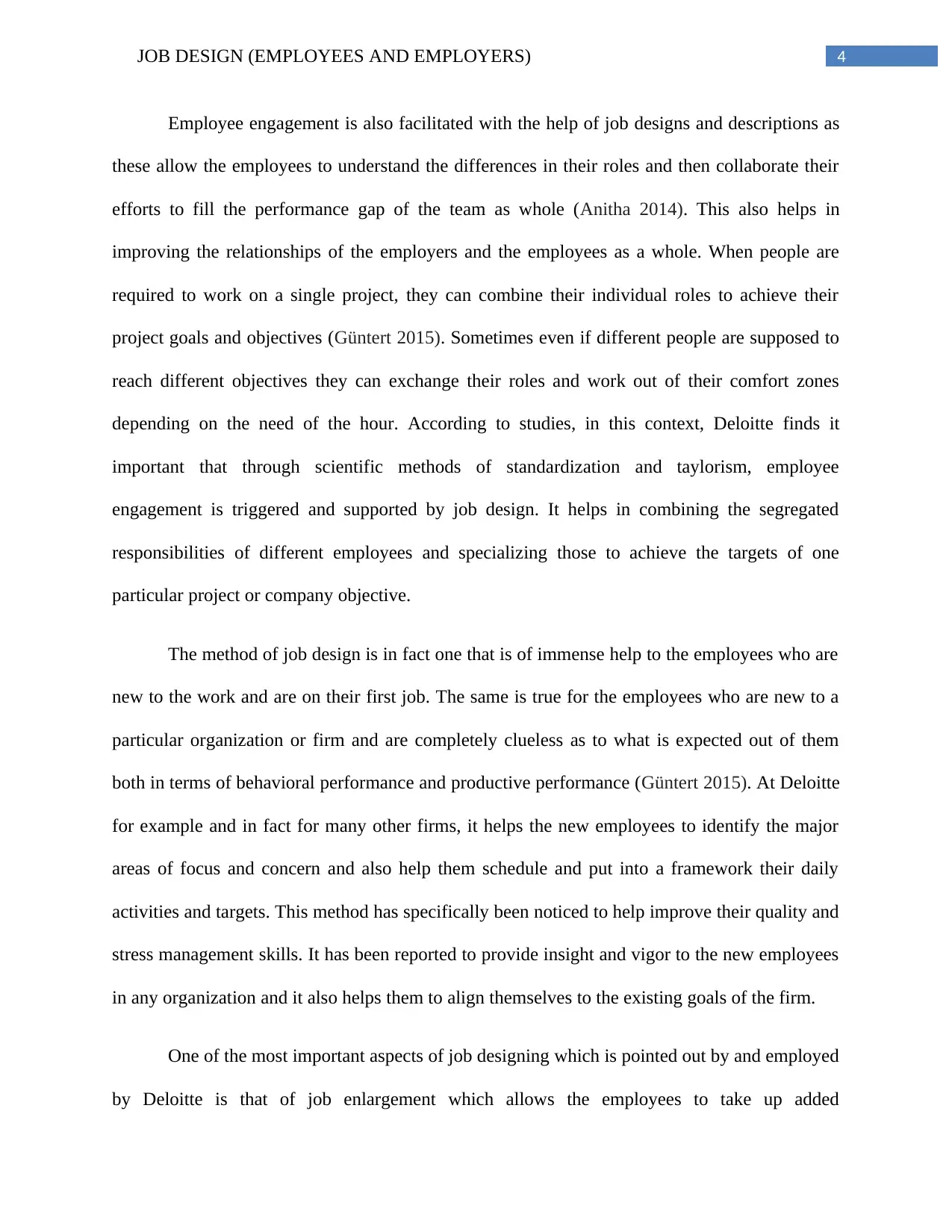
4JOB DESIGN (EMPLOYEES AND EMPLOYERS)
Employee engagement is also facilitated with the help of job designs and descriptions as
these allow the employees to understand the differences in their roles and then collaborate their
efforts to fill the performance gap of the team as whole (Anitha 2014). This also helps in
improving the relationships of the employers and the employees as a whole. When people are
required to work on a single project, they can combine their individual roles to achieve their
project goals and objectives (Güntert 2015). Sometimes even if different people are supposed to
reach different objectives they can exchange their roles and work out of their comfort zones
depending on the need of the hour. According to studies, in this context, Deloitte finds it
important that through scientific methods of standardization and taylorism, employee
engagement is triggered and supported by job design. It helps in combining the segregated
responsibilities of different employees and specializing those to achieve the targets of one
particular project or company objective.
The method of job design is in fact one that is of immense help to the employees who are
new to the work and are on their first job. The same is true for the employees who are new to a
particular organization or firm and are completely clueless as to what is expected out of them
both in terms of behavioral performance and productive performance (Güntert 2015). At Deloitte
for example and in fact for many other firms, it helps the new employees to identify the major
areas of focus and concern and also help them schedule and put into a framework their daily
activities and targets. This method has specifically been noticed to help improve their quality and
stress management skills. It has been reported to provide insight and vigor to the new employees
in any organization and it also helps them to align themselves to the existing goals of the firm.
One of the most important aspects of job designing which is pointed out by and employed
by Deloitte is that of job enlargement which allows the employees to take up added
Employee engagement is also facilitated with the help of job designs and descriptions as
these allow the employees to understand the differences in their roles and then collaborate their
efforts to fill the performance gap of the team as whole (Anitha 2014). This also helps in
improving the relationships of the employers and the employees as a whole. When people are
required to work on a single project, they can combine their individual roles to achieve their
project goals and objectives (Güntert 2015). Sometimes even if different people are supposed to
reach different objectives they can exchange their roles and work out of their comfort zones
depending on the need of the hour. According to studies, in this context, Deloitte finds it
important that through scientific methods of standardization and taylorism, employee
engagement is triggered and supported by job design. It helps in combining the segregated
responsibilities of different employees and specializing those to achieve the targets of one
particular project or company objective.
The method of job design is in fact one that is of immense help to the employees who are
new to the work and are on their first job. The same is true for the employees who are new to a
particular organization or firm and are completely clueless as to what is expected out of them
both in terms of behavioral performance and productive performance (Güntert 2015). At Deloitte
for example and in fact for many other firms, it helps the new employees to identify the major
areas of focus and concern and also help them schedule and put into a framework their daily
activities and targets. This method has specifically been noticed to help improve their quality and
stress management skills. It has been reported to provide insight and vigor to the new employees
in any organization and it also helps them to align themselves to the existing goals of the firm.
One of the most important aspects of job designing which is pointed out by and employed
by Deloitte is that of job enlargement which allows the employees to take up added
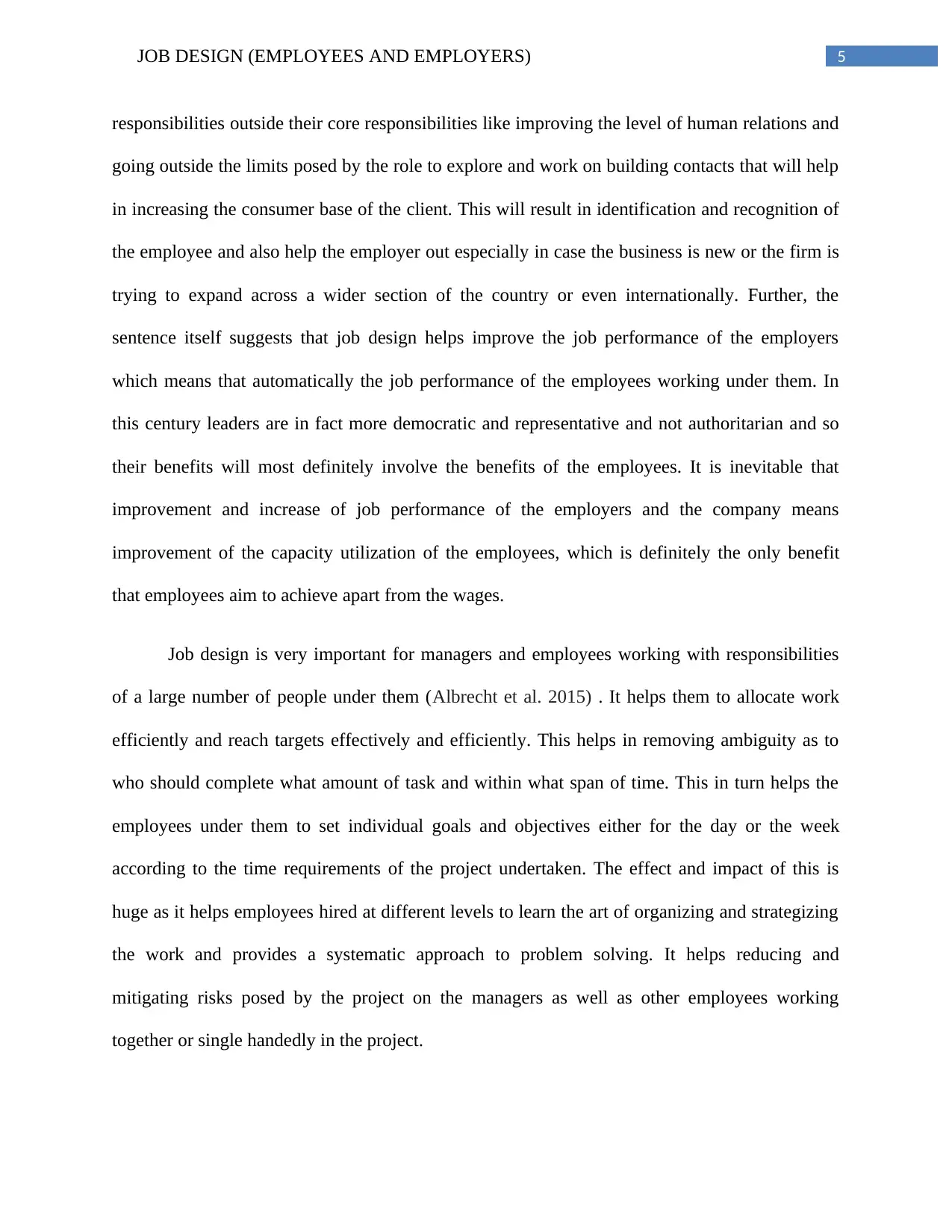
5JOB DESIGN (EMPLOYEES AND EMPLOYERS)
responsibilities outside their core responsibilities like improving the level of human relations and
going outside the limits posed by the role to explore and work on building contacts that will help
in increasing the consumer base of the client. This will result in identification and recognition of
the employee and also help the employer out especially in case the business is new or the firm is
trying to expand across a wider section of the country or even internationally. Further, the
sentence itself suggests that job design helps improve the job performance of the employers
which means that automatically the job performance of the employees working under them. In
this century leaders are in fact more democratic and representative and not authoritarian and so
their benefits will most definitely involve the benefits of the employees. It is inevitable that
improvement and increase of job performance of the employers and the company means
improvement of the capacity utilization of the employees, which is definitely the only benefit
that employees aim to achieve apart from the wages.
Job design is very important for managers and employees working with responsibilities
of a large number of people under them (Albrecht et al. 2015) . It helps them to allocate work
efficiently and reach targets effectively and efficiently. This helps in removing ambiguity as to
who should complete what amount of task and within what span of time. This in turn helps the
employees under them to set individual goals and objectives either for the day or the week
according to the time requirements of the project undertaken. The effect and impact of this is
huge as it helps employees hired at different levels to learn the art of organizing and strategizing
the work and provides a systematic approach to problem solving. It helps reducing and
mitigating risks posed by the project on the managers as well as other employees working
together or single handedly in the project.
responsibilities outside their core responsibilities like improving the level of human relations and
going outside the limits posed by the role to explore and work on building contacts that will help
in increasing the consumer base of the client. This will result in identification and recognition of
the employee and also help the employer out especially in case the business is new or the firm is
trying to expand across a wider section of the country or even internationally. Further, the
sentence itself suggests that job design helps improve the job performance of the employers
which means that automatically the job performance of the employees working under them. In
this century leaders are in fact more democratic and representative and not authoritarian and so
their benefits will most definitely involve the benefits of the employees. It is inevitable that
improvement and increase of job performance of the employers and the company means
improvement of the capacity utilization of the employees, which is definitely the only benefit
that employees aim to achieve apart from the wages.
Job design is very important for managers and employees working with responsibilities
of a large number of people under them (Albrecht et al. 2015) . It helps them to allocate work
efficiently and reach targets effectively and efficiently. This helps in removing ambiguity as to
who should complete what amount of task and within what span of time. This in turn helps the
employees under them to set individual goals and objectives either for the day or the week
according to the time requirements of the project undertaken. The effect and impact of this is
huge as it helps employees hired at different levels to learn the art of organizing and strategizing
the work and provides a systematic approach to problem solving. It helps reducing and
mitigating risks posed by the project on the managers as well as other employees working
together or single handedly in the project.
⊘ This is a preview!⊘
Do you want full access?
Subscribe today to unlock all pages.

Trusted by 1+ million students worldwide
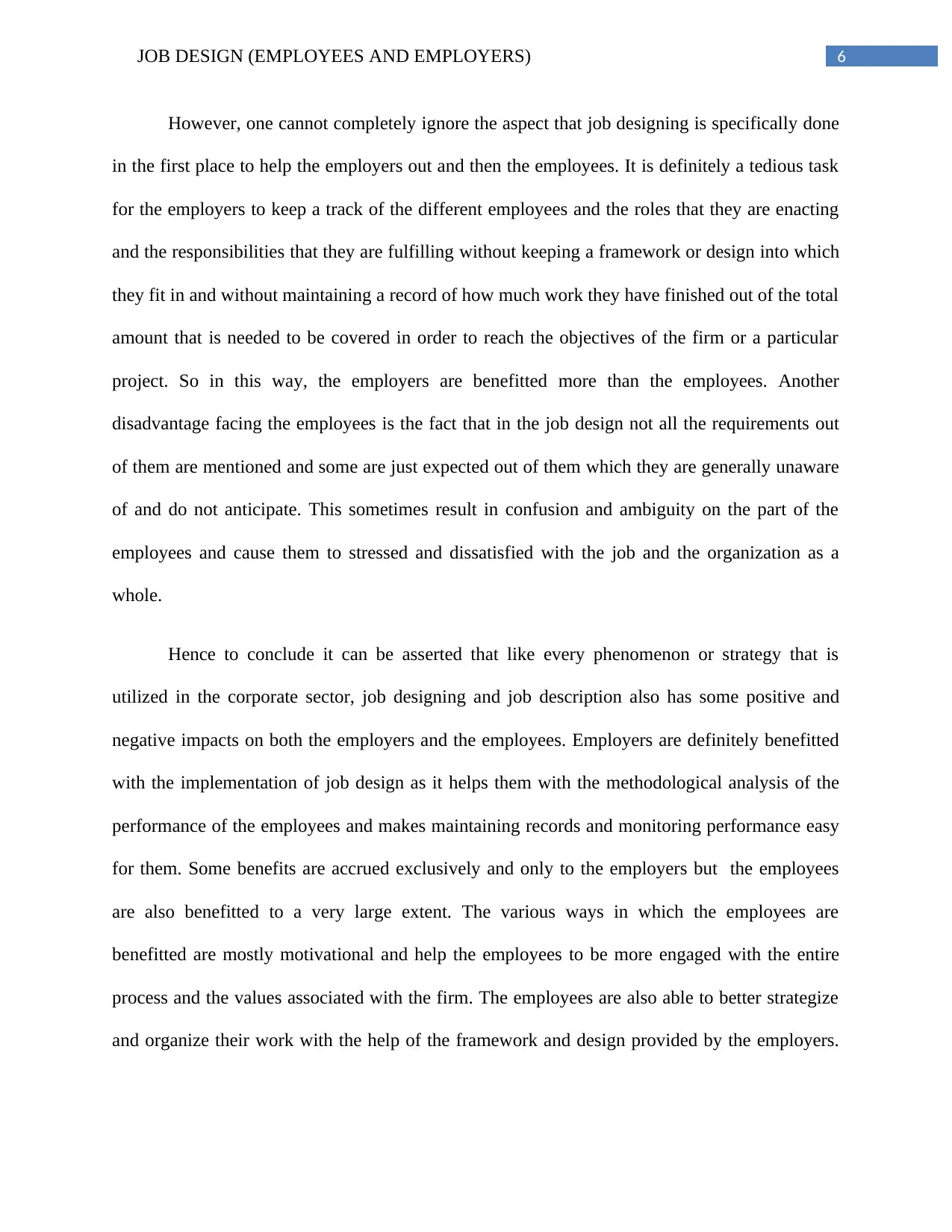
6JOB DESIGN (EMPLOYEES AND EMPLOYERS)
However, one cannot completely ignore the aspect that job designing is specifically done
in the first place to help the employers out and then the employees. It is definitely a tedious task
for the employers to keep a track of the different employees and the roles that they are enacting
and the responsibilities that they are fulfilling without keeping a framework or design into which
they fit in and without maintaining a record of how much work they have finished out of the total
amount that is needed to be covered in order to reach the objectives of the firm or a particular
project. So in this way, the employers are benefitted more than the employees. Another
disadvantage facing the employees is the fact that in the job design not all the requirements out
of them are mentioned and some are just expected out of them which they are generally unaware
of and do not anticipate. This sometimes result in confusion and ambiguity on the part of the
employees and cause them to stressed and dissatisfied with the job and the organization as a
whole.
Hence to conclude it can be asserted that like every phenomenon or strategy that is
utilized in the corporate sector, job designing and job description also has some positive and
negative impacts on both the employers and the employees. Employers are definitely benefitted
with the implementation of job design as it helps them with the methodological analysis of the
performance of the employees and makes maintaining records and monitoring performance easy
for them. Some benefits are accrued exclusively and only to the employers but the employees
are also benefitted to a very large extent. The various ways in which the employees are
benefitted are mostly motivational and help the employees to be more engaged with the entire
process and the values associated with the firm. The employees are also able to better strategize
and organize their work with the help of the framework and design provided by the employers.
However, one cannot completely ignore the aspect that job designing is specifically done
in the first place to help the employers out and then the employees. It is definitely a tedious task
for the employers to keep a track of the different employees and the roles that they are enacting
and the responsibilities that they are fulfilling without keeping a framework or design into which
they fit in and without maintaining a record of how much work they have finished out of the total
amount that is needed to be covered in order to reach the objectives of the firm or a particular
project. So in this way, the employers are benefitted more than the employees. Another
disadvantage facing the employees is the fact that in the job design not all the requirements out
of them are mentioned and some are just expected out of them which they are generally unaware
of and do not anticipate. This sometimes result in confusion and ambiguity on the part of the
employees and cause them to stressed and dissatisfied with the job and the organization as a
whole.
Hence to conclude it can be asserted that like every phenomenon or strategy that is
utilized in the corporate sector, job designing and job description also has some positive and
negative impacts on both the employers and the employees. Employers are definitely benefitted
with the implementation of job design as it helps them with the methodological analysis of the
performance of the employees and makes maintaining records and monitoring performance easy
for them. Some benefits are accrued exclusively and only to the employers but the employees
are also benefitted to a very large extent. The various ways in which the employees are
benefitted are mostly motivational and help the employees to be more engaged with the entire
process and the values associated with the firm. The employees are also able to better strategize
and organize their work with the help of the framework and design provided by the employers.
Paraphrase This Document
Need a fresh take? Get an instant paraphrase of this document with our AI Paraphraser
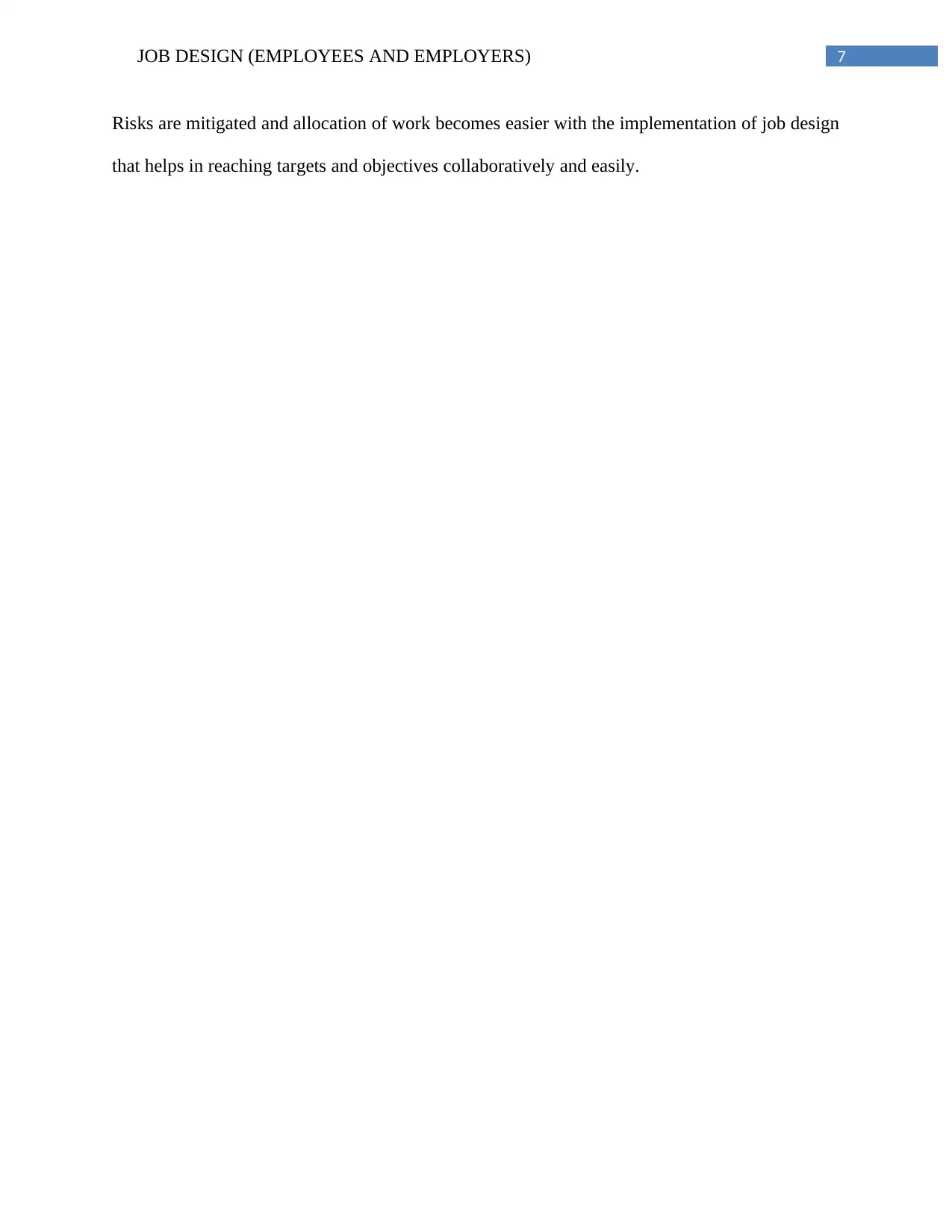
7JOB DESIGN (EMPLOYEES AND EMPLOYERS)
Risks are mitigated and allocation of work becomes easier with the implementation of job design
that helps in reaching targets and objectives collaboratively and easily.
Risks are mitigated and allocation of work becomes easier with the implementation of job design
that helps in reaching targets and objectives collaboratively and easily.
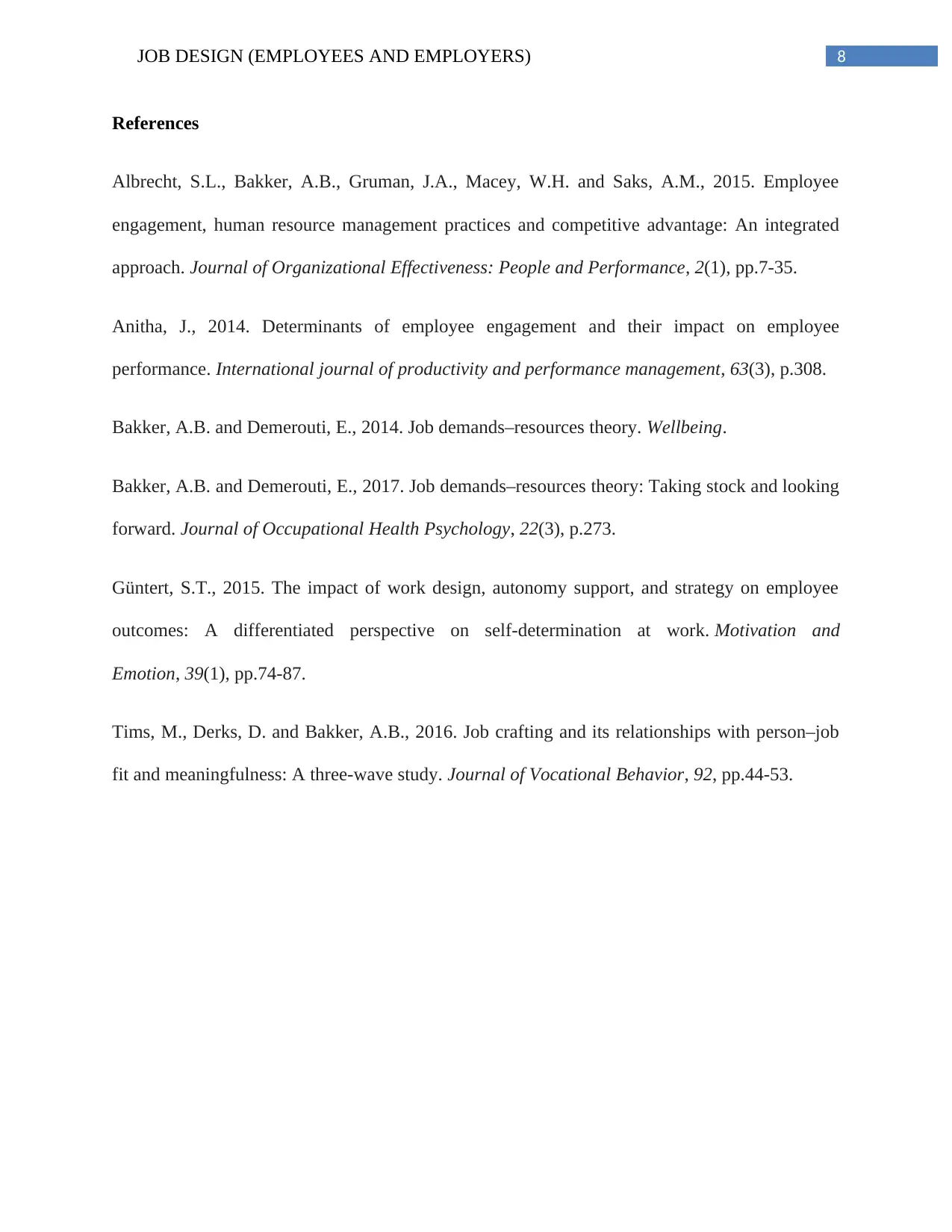
8JOB DESIGN (EMPLOYEES AND EMPLOYERS)
References
Albrecht, S.L., Bakker, A.B., Gruman, J.A., Macey, W.H. and Saks, A.M., 2015. Employee
engagement, human resource management practices and competitive advantage: An integrated
approach. Journal of Organizational Effectiveness: People and Performance, 2(1), pp.7-35.
Anitha, J., 2014. Determinants of employee engagement and their impact on employee
performance. International journal of productivity and performance management, 63(3), p.308.
Bakker, A.B. and Demerouti, E., 2014. Job demands–resources theory. Wellbeing.
Bakker, A.B. and Demerouti, E., 2017. Job demands–resources theory: Taking stock and looking
forward. Journal of Occupational Health Psychology, 22(3), p.273.
Güntert, S.T., 2015. The impact of work design, autonomy support, and strategy on employee
outcomes: A differentiated perspective on self-determination at work. Motivation and
Emotion, 39(1), pp.74-87.
Tims, M., Derks, D. and Bakker, A.B., 2016. Job crafting and its relationships with person–job
fit and meaningfulness: A three-wave study. Journal of Vocational Behavior, 92, pp.44-53.
References
Albrecht, S.L., Bakker, A.B., Gruman, J.A., Macey, W.H. and Saks, A.M., 2015. Employee
engagement, human resource management practices and competitive advantage: An integrated
approach. Journal of Organizational Effectiveness: People and Performance, 2(1), pp.7-35.
Anitha, J., 2014. Determinants of employee engagement and their impact on employee
performance. International journal of productivity and performance management, 63(3), p.308.
Bakker, A.B. and Demerouti, E., 2014. Job demands–resources theory. Wellbeing.
Bakker, A.B. and Demerouti, E., 2017. Job demands–resources theory: Taking stock and looking
forward. Journal of Occupational Health Psychology, 22(3), p.273.
Güntert, S.T., 2015. The impact of work design, autonomy support, and strategy on employee
outcomes: A differentiated perspective on self-determination at work. Motivation and
Emotion, 39(1), pp.74-87.
Tims, M., Derks, D. and Bakker, A.B., 2016. Job crafting and its relationships with person–job
fit and meaningfulness: A three-wave study. Journal of Vocational Behavior, 92, pp.44-53.
⊘ This is a preview!⊘
Do you want full access?
Subscribe today to unlock all pages.

Trusted by 1+ million students worldwide
1 out of 9
Related Documents
Your All-in-One AI-Powered Toolkit for Academic Success.
+13062052269
info@desklib.com
Available 24*7 on WhatsApp / Email
![[object Object]](/_next/static/media/star-bottom.7253800d.svg)
Unlock your academic potential
Copyright © 2020–2025 A2Z Services. All Rights Reserved. Developed and managed by ZUCOL.





